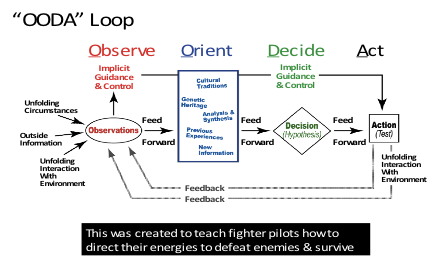The Situation:
Your adversary is attacking your case in the mediation in such a manner that good faith negotiations seem like a distant cousin to all out war. You are looking for a way to recover. You don’t want to walk out of the room, but you are running out of options and the negotiation is looking dim.
The Solution:
Get inside your adversary’s decision methodology through use of the OODA loop, a concept developed by military strategist John Boyd that allows you to get inside your adversary’s decision cycle and gain a strategic advantage in a negotiation.
“OODA” stands for Observe, Orient, Decide and Act. The goal is to observe and react to unfolding events more rapidly than your opponent so that you can stay one move ahead. Since decision-making occurs in a recurring OODA loop cycle, this strategy allows you to continuously move from one loop to the next by recognizing the evolving situation and quickly adapting your strategy by obscuring your intentions and making them unpredictable to your adversary. You operate at a faster tempo to generate some element of confusion and disorder which forces your adversary to clarify his intentions. By allowing some chaos and confusion to enter the negotiation, the use of the OODA loop funnels the chaos in the direction of the adversary.

This strategy was employed in the 1991 Gulf War in which Saddam Hussein positioned his infamous Republican Guard on the border between Iraq and Kuwait expecting the American military to hit him head on. Instead, American military leaders observed the unfolding situation on the ground, oriented themselves to the culture of the Iraq military, decided to place decoys in front of the Republican Guard and took action by flanking them from the side. History shows that the Republican Guard did not know what hit them when the American military surrounded their positions and they quickly surrendered.
Similarly, in litigated cases, the structure of the OODA can be adapted in various ways. One example would be to work the edges when your adversary keeps hitting you head on with facts that don’t seem to help jump-start a fair negotiation. Start by observing the unfolding circumstances and assessing the orientation of the defendant. For example, determine if there is an internal constraint preventing the defendant from developing a fair approach to settlement. It could be something as simple as a claims adjuster having just inherited the file and not having written up a proper reserve yet, or an adjuster missing basic information about your client’s treatment. Instead of letting you know this, the adjuster’s,cultural orientation is to “push back” and deny any possibility of settlement. If you in turn push back at this point, the possibility of settlement will fall off instantaneously and you will have no ability to negotiate. The feedback you receive by observing and orienting to the defendant’s decision process will allow you to analyze and synthesize what is going on in the other room then you can take action which creates some confusion in your adversary’s mind, disrupting the typical pattern that results in failure of a mediation. Allowing yourself to get stuck in your adversary’s pattern is what we call, in the litigation world, an “impasse.” Stay one step ahead of your adversaries by creating an OODA pattern that might flank them from the side.
________________________
To make sure you do not miss out on regular updates from the Kluwer Mediation Blog, please subscribe here.


